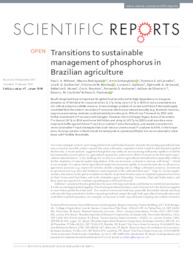Transitions to sustainable management of phosphorus in Brazilian agriculture.
Transitions to sustainable management of phosphorus in Brazilian agriculture.
Author(s): WITHERS, P. J. A.; RODRIGUES, M.; SOLTANGHEISI, A.; CARVALHO, T. S. de; GUILHERME, L. R. G.; BENITES, V. de M.; GATIBONI, L. C.; SOUSA, D. M. G. de; NUNES, R. de S.; ROSOLEM, C. A.; ANDREOTE, F. D.; OLIVEIRA JUNIOR, A. de; COUTINHO, E. L. M.; PAVINATO, P. S.
Summary: Brazil's large land base is important for global food security but its high dependency on inorganic phosphorus (P) fertilizer for crop production (2.2 Tg rising up to 4.6 Tg in 2050) is not a sustainable use of a critical and price-volatile resource. A new strategic analysis of current and future P demand/supply concluded that the nation's secondary P resources which are produced annually (e.g. livestock manures, sugarcane processing residues) could potentially provide up to 20% of crop P demand by 2050 with further investment in P recovery technologies. However, the much larger legacy stores of secondary P in the soil (30 Tg in 2016 worth over $40 billion and rising to 105 Tg by 2050) could provide a more important buffer against future P scarcity or sudden P price fluctuations, and enable a transition to more sustainable P input strategies that could reduce current annual P surpluses by 65%. In the longer-term, farming systems in Brazil should be redesigned to operate profitably but more sustainably under lower soil P fertility thresholds.
Publication year: 2018
Types of publication: Journal article
Unit: Embrapa Soils
Keywords: Administração Agrícola, Agricultura, Fertilizante fosfatado, Fósforo
Observation
Some of Embrapa's publications are published as ePub files. To read them, use or download one of the following free software options to your computer or mobile device. Android: Google Play Books; IOS: iBooks; Windows and Linux: Calibre.
Access other publications
Access the Agricultural Research Database (BDPA) to consult Embrapa's full library collection and records.
Visit Embrapa Bookstore to purchase books and other publications sold by Embrapa.

